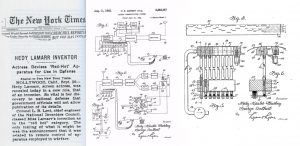Earlier this month, I was able to attend the movie screening of “Bombshell: The Hedy Lamarr Story.” After the movie screening, there was a discussion on the film with a panel of very accomplished females who worked here at NC State. The panel includes: Dr. Laura Bottomley (Director, Women in Engineering), Dr. Frances Ligler (Lampe Distinguished Professor of Biomedical Engineering and National Inventors Hall of Fame member), and Dr. Mary Wyer (Associate Professor of  Psychology and Women’s and Gender Studies). Lamarr was originally born Hedwig Kiesler in Austria in 1914. She grew up in Vienna with both of her parents; there she took an interest in acting because of her fascination with the theatre. Lamarr arrived at the United States after meeting Louis B. Mayer and impressing him enough to land a $500 a week contract. At her height, she was known as the “world’s most beautiful women” and has inspired many characters because of her beauty. Her features were use as an inspiration for Disney’s Snow White and Catwomen.
Psychology and Women’s and Gender Studies). Lamarr was originally born Hedwig Kiesler in Austria in 1914. She grew up in Vienna with both of her parents; there she took an interest in acting because of her fascination with the theatre. Lamarr arrived at the United States after meeting Louis B. Mayer and impressing him enough to land a $500 a week contract. At her height, she was known as the “world’s most beautiful women” and has inspired many characters because of her beauty. Her features were use as an inspiration for Disney’s Snow White and Catwomen.
Along with her acting career Lamarr, also had a peculiar interest in inventing items, it was one of her favorite hobbies. Countless of friends recall in the movie how she had a lab set up in her house and movie trailer. Some of her inventions include an improved traffic light and a tablet that would allow water to become a carbonated drink. She even helps Howard Hughes, an aviation tycoon, by suggesting he change the wing on his aircraft from a square design to the winged ones we see today. She recalls thinking of the idea by putting together pictures of the fastest birds and fish she can find.
Also, Lamarr was very serious about helping soldiers during the wartime. Seeing the change that the Nazi regime brought to her hometown was one of a significant reason she fled, and she wanted to do anything to help the soldiers beat them. There, she learned about how radio-controlled torpedoes could be easily jammed and set off course when German U-boats found the frequency. With this problem in mind, she thought of a device that could hop frequency so quickly that the enemies will not be able to catch the signal. Next, she contacts friend and composer George Antheil, to help her developed a device for her plan. Soon the two drafted designs and were granted a patent, US Patent 2,292,387 on August 11, 1942. However, at the time their invention was put aside because it didn’t come from someone inside the military and Lamarr was told her efforts was better put to use to sell war bonds (which she did and sold over 7 million dollars at the time, which would roughly be 123 million today).

Nevertheless, their patent would be pick up again and be improve to be used in the Cuban Missiles Crisis and continue to be used in other military applications. There “frequency hopping” idea did not only help the military but began to be used for the foundation of Wi-Fi, Bluetooth, and other wireless operations. Lamarr receives almost no recognition of her invention at the time, and she honestly had no clue her patent was being put to use. Finally, in 1997, she and George Antheil were honored with the Electronic Frontier Foundation (EFF) Pioneer Award. Also, she became the first woman to receive the Invention Convention’s BULBIE Gnass Spirit of Achievement Award. If you have time, I highly recommend watching the movie, “Bombshell: The Hedy Lamarr Story.” , its highly informative on Lamarr life and the mindset of people during that time.
-Danielle Dantzler
